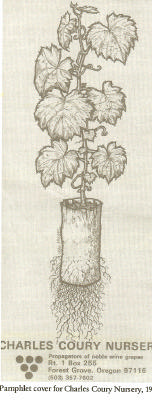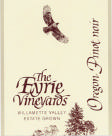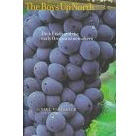Oregon Relishes Burgundian Influence
The pioneers of Oregon Pinot Noir were emigrants from California. Charles Coury (Charles Coury Winery),
David Lett (Eyrie Vineyards), Dick Ponzi (Ponzi Vineyards), and Dick Erath (Knudsen Erath, now Erath Vineyards),
headed north to Oregon in the 1960s when the thrust of the California wine industry was Cabernet and
very little Pinot Noir was being produced. There were only five premium wineries in Napa Valley at the time.
Dick Ponzi had searched in California for suitable growing sites for Pinot Noir, including the Anderson Valley,
but found land prices too steep. Bill Blosser, who was to found Sokol Blosser Vinery in 1970, also looked at
California first. Napa’s Gary Andurs established Archery Summit in the 1980s, Napa’s Carl Doumani and Steve
Girard started Benton Lane, and Napa’s William Hill opened Van Duzer. These prospective winegrowers were
not only deterred by unaffordable land prices, but also by California winemaking which emphasized pumps,
filters and other technology suitable for many varietals, but undesirable for Pinot Noir. It was only natural that
Oregon looked to Burgundy for guidance.
By 1981, Oregon had begun its Steamboat Conference (which was not open to consumers or wine writers) with
the original intention of sharing information between winemakers from Oregon and California. It was the
Burgundians who began attending this event that created the most impression on Oregon winemakers. Robert
Drouhin of Domaine Drouhin in Beaune, France, had visited Oregon in the 1970s and in 1987, purchased 180
acres in the Dundee Hills. Named Domaine Drouhin Oregon (DDO), this French-inspired winery really brought
vindication and notoriety to the Oregon wine industry and helped to foster a long standing interchange between
Oregonians and Burgundians. The Burgundians have since participated with regularity in the Steamboat
Conference as well as the International Pinot Noir Celebration which occurs shortly after Steamboat each July.
Oregon has had plenty in common with Burgundy. The midpoint of the Willamette Valley lies at 45 degrees
north latitude, the same as for Burgundy’s Cote d’Or. Vintages in Oregon tend to parallel those in Burgundy
(see Oregon vintage rundown on page 4). Oregon wineries have always been small, family-owned affairs, just
like in Burgundy. The Dijon clones of Pinot Noir were first brought into this country by workers at Oregon State
University who had a close working relationship with the Burgundians.
A number of people think that Oregon is rife with hippies making wine out of garages in their backyards. That
may have been largely true back in the late 1960s, but today Oregon Pinot Noir is crafted by a group of talented
and dedicated winegrowers. They may sport beards, ponytails, and a laid back attitude, but the Pinot Noir they
produce is world-class.
Vinifera grapes were first planted in Oregon as far back as 1828 (about the time they were introduced into
California). The wine industry’s modern era was ushered in by pioneering winegrower Richard Somner of
Hillcrest Vineyard in Roseburg in the Umpqua Valley. He planted Riesling in 1961 and was the first to produce
commercial quality wine in Oregon. Somner is largely forgotten, because most winegrowers followed David
Lett to the Willamette Valley, 150 miles to the north, presumably because it was much closer to Portland.

The modern Pinot Noir Era in Oregon began in 1965 with the arrival of
Charles and Shirley Coury who purchased an abandoned 45-acre vineyard
near Forest Grove. Coury’s name has been somewhat lost in the history of
Pinot Noir in Oregon, often eclipsed by David Lett, who arrived in Oregon
about the same time and carries the moniker, “Papa Pinot.” While at University
of California Davis in 1962, Chuck Coury, Bill Fuller, David Lett and Bruno
Pilone were the only four students in the Department of Enology and Viticulture.
Coury wrote a master thesis titled, “Cold Climate Amelioration Hypothesis,”
in which he hypothesized that vinifera varietals produce their best
quality wines when ripened just at the limit of their growing season. This
hypothesis is common sense today, but in 1963, the idea was revolutionary.
Coury chose Oregon as the best place to prove his hypothesis and in 1965
planted Pinot Noir in his vineyard there. David Lett and Bill Fuller followed
Coury to Oregon shortly thereafter. Coury became the second winemaker in
post-Prohibition Oregon to produce a decent commercial wine. He operated
the Charles Coury Winery, Vineyards and Nursery until 1978. Coury was also
one of the first winegrowers in this country to take an interest in Pinot Noir
clones. According to John Haeger in North American Pinot Noir, he reputedly
brought ‘suitcase clones” to Oregon from Burgundy in the 1960s. The historic
Coury property is now the David Hill Winery.
Coury was a leader and educator for newcomers. His ideas led to the formulation
of Oregon’s labeling regulations, quarantines on plant material, and
the establishment of the viticultural research center at Oregon State University. In 1971, he was actively
teaching viticulture at Rogue Community College. According to people who knew Coury, his
early Pinot Noirs were world class.
In the 1980s, Coury left Oregon and returned to California to begin a venture in the microbrewery industry.
He passed away on June 23, 2004 from lung cancer at the age of 73. He is remembered as
setting the vision for the current Oregon wine industry.

Utah-born, David Lett, had a BA in philosophy before beginning his wine studies at Davis. His professor,
Harold Berg, had told him that there were very few climates in the United States cool enough for
the successful cultivation of Pinot Noir. Lett was committed to planting Pinot Noir and considered both
New Zealand and Portugal. He kept coming back to Oregon, thinking it was the closest climate to
Burgundy. Finally, at age 25, he moved to Oregon’s Dundee Hills with 3,000 vine
cuttings. In 1965 he planted Pinot Noir and related varietals, despite the warnings of
his colleagues that the grapes would never ripen in the cold Oregon climate.
Whether Coury or Lett planted the first Pinot Noir in Oregon is up for dispute and it
little matters as they both made significant contributions to the fledgling Oregon
wine industry. Lett’s first harvest was in 1970, a year after Woodstock, and he sold a
few hundred cases of “Oregon Spring Wine” for $2.65 a bottle. Supposedly he sent
out four hundred invitations to a release party and received only one response. His
beginnings were inauspicious, but the wines improved with every vintage and the
Oregon Pinot Noir Era was off and running.
In 1979, Robert Drouhin set up a blind tasting of French Burgundies versus American Pinot Noirs. At
the Gault-Mileu tasting held in Paris, a 1959 Domaine Drouhin Chambolle-Musigny came in first, but
David Lett’s 1975 Eyrie Vineyards South Block Reserve Pinot Noir took second. Lett’s Pinot Noirs have
since become well-known for their age ability. Today, he has 50 acres of organically farmed, own-rooted, non-irrigated vines producing 8,000-10,000 cases annually. His son, Jason Lett, handles the
main winegrowing chores now. David Lett has been producing a single vineyard Pinot Noir longer
than any other winemaker in the United States. In addition, he was the first to produce a New World
Pinot Gris in 1970. About the time that Lett’s Pinot Noir astonished the international wine scene, there
were 34 bonded Oregon wineries farming 1,100 acres of vineyards.

The history of many of the wine pioneers that followed Coury and Lett to Yamhill County are told in the
excellent book written by Kerry McDaniel Boenisch titled,
Vineyard Memoirs: Oregon Wine Pioneer
Recollections of Living, Grape-Growing and Winemaking in the 1970’s (CKMB, PO Box 512, Dundee,
Oregon 97115, 2004). The Sokol Blossers, with no agricultural background or
training, purchased an abandoned prune orchard in 1970 and planted vines two
years later. Their story is chronicled in the book,
At Home in the Vineyard: Cultivating
a Winery, an Industry, and a Life, authored by Susan Sokol Blosser. Dick
and Kina Erath came to Oregon in 1968. They purchased a 49-acre site in the
Chahalem Mountains above Newberg. In 1975, they formed a partnership with
C. Calvert Knudsen (Knudsen-Erath Winery) which lasted until the 1980s. Knudsen
went on to form an Argyle partnership in 1985. Dick Erath’s story is told in
the book,
Boys Up North: Dick Erath and the Early Oregon Winemakers, written
by Paul Pintarich.
There were many other early winegrowers of importance: David Adelsheim (Adelsheim Vineyard),
Dick Ponzi (Ponzi Winery & Vineyards), Fred Arterberry (Arterberry Winery, now Duck Pond), Jim and
Loie Maresh (Dick Erath’s first grower, today they still own Maresh Red Barn B&B and the Maresh
Vineyard, planted in 1970), Jim and Donna Jean McDaniel (now Torii Mor Winery), Bill and Bessie
Archibald (vineyard now owned by Archery Summit), Dr, John and Sally Bavers, Gary and Saundra
Fuqua, Tom and Sharon Saucy, and Dan and Christine Jepson.
In 1970, there were 5 wineries and 35 vineyard acres in Oregon. The number of wineries has tripled in
the last decade and last year alone 49 new wineries opened their doors. There are now at least 364
wineries producing wine from 72 different varietals. Oregon has the third largest number of wineries
in the United States behind California (1,905) and Washington state (430). Pinot Noir is the most widely
planted grape by far (nearly 80% of all vineyard plantings), and nearly half of Oregon’s total case
sales are Pinot Noir. Wine grape growers harvested 13,381 acres in 2006, and of those about 9,000
were Pinot Noir. Wine grape crops in 2006 posted gross sales of $46.7 million, an increase of 27.6%
over 2005. 2006 saw the largest sales rise in seven years, the largest jump in production in the last
decade, and the biggest increase in harvested acres in the last 10 years (11,344 acres in 2005, 6,300
acres in 1997).
Although Oregon has done well to promote its healthy wine industry, a few curiosities arise. The state
beverage is milk despite the fact that wine is now the state’s most visible agricultural product. The
state flower is the Oregon grape which is actually a holly bush and not a wine grape plant at all. Rain is
synonymous with Oregon, but unfairly so, for in the Willamette Valley, there is no more rain than other
cool climate wine growing regions of the world. That is not to say that rain isn’t a problem, for much of
Oregon’s rainfall occurs in the spring and fall (as well as through the winter), with dry conditions in
mid-summer.
Oregon has made many commendable contributions to the modern success of Pinot Noir. The winemakers
here were among the first to embrace exclusive use of French oak barrels, new and old. Strict
labeling laws in the state require any wine labeled Pinot Noir to be 100% Pinot Noir . The LIVE (Low
Input Viticulture and Enology Program) certification program begun in 1997 by Ted Casteel of Bethel
Heights, requires designated wineries to use minimal chemical additives, no off-farm chemicals and
fertilizers, and strive for maximal biodiversity.
Oregon Vintages 1982-2007
In the earlier years, crop thinning was crucial. 1995 through 1997 were the “rain years.” Since 1999,
vintages have been more consistent in part due to improved winegrowing know how.
1982 Decent, soft wines, no longer drinkable.
1983 Big, tannic wines.
1984 A rainy vintage, mostly poor wines.
1985 An excellent vintage with ripe and concentrated wines.
1986 Many are lean and tannic, variable vintage.
1987 Again, variable with some very good wines.
1988 A classic year with balanced wines that were generally excellent.
1989 A hot year, wines were good if not picked too late.
1990 Cold winter and cool spring, low yields, some great wines.
1991 Late, ripe harvest.
1992 Good vintage. A hot year, but heat declined near harvest. Some very good wines.
1993 Fall was warm and dry resulting in long hang times. Some good wines.
1994 More fruit-forward California-styled wines. A hot season. Wines were ripe and flashy.
1995 Rainy vintage, many dilute wines.
1996 Rain at harvest, variable vintage, often tannic wines.
1997 Rain and more rain resulting in high yields, many watery and tannic wines.
1998 Cool weather at bud break led to reduced yields. Classic, concentrated wines lacking acidity.
1999 One of Oregon’s finest vintages. The wines have aged very well due to perfect balance. The
best wines came from those who dropped fruit anticipating the rains near harvest.
2000 A very good vintage with noteworthy aromatics in the wines.
2001 Excellent vintage that ranks close to 1999, especially for wineries that restricted yields.
2002 May be Oregon’s finest vintage ever. Wines have perfect balance and classic Pinot flavors.
2003 A record year for heat. Many wines are extracted, high in alcohol, high in tannin, with low
acidity.
2004 Another excellent vintage with balanced flavors, acidity and tannins. A challenging vintage
with rains in September which left before final ripening. Low yields.
2005 Rain and cool weather in the Spring and at harvest. Challenging vintage with irregular flowering.
Harvest went well into November for many wineries. Wines have higher acidity.
2006 Record yields due to higher than normal rainfall in the winter. Dry summer. Large average
cluster size. High quality, clean fruit.
2007 So far, so good. Mild summer, veraison only recently.





